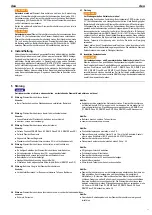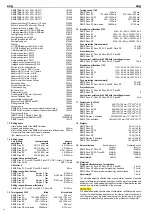
Make sure that the suction hose of the safety vacuum cleaner/dust extractor
does not kink and impair the dust extraction. Also make sure that no loosened
lumps of rock or other objects jam in the diamond core drilling crown, the drive
unit’s suction rotor and/or the suction hose. Empty the dust bag of the safety
vacuum cleaner/dust extractor early and clean/renew the fi lter regularly. Observe
the operating instructions of the safety vacuum cleaner/dust extractor.
If the dust produced by dry drilling is not removed, the diamond core drilling
crown may overheat and suffer damage. There is also a risk that the drilling
dust compressed in the drilling gap will block the diamond core drilling crown.
NOTICE
NOTICE
If insuffi cient thrust pressure is applied when performing hand-held drilling with
REMS Picus DP and micro-pulse technology switched on, the micro-pulse
technology adjusting ring (Fig. 10 (69)) can turn during drilling and switch off
the micro-pulse. Switch off the drive unit in this case. Turn the micro-pulse
technology adjusting ring (Fig. 10 (69)) to the detent position so that the red
markings are in line. Continue drilling with increased thrust pressure. It is
recommended to use a drill stand if the micro-pulse technology switches off
repeatedly.
NOTICE
NOTICE
Always wet drilling with REMS universal diamond core drilling crowns
and REMS universal diamond core drilling crowns LS for steel-reinforced
concrete!
Always dry drilling with REMS dry diamond core drilling crowns LS with
core drilling machines with micro-pulse technology. Suck off the resulting
drilling dust with a suitable safety vacuum cleaner/dust extractor! Observe
the national regulations.
3.2 Manually-controlled wet drilling REMS Picus S1, REMS Picus S3 and
REMS Picus SR
WARNING
WARNING
Use the counterholder (12) provided with the diamond core drilling machine for
hand-held drilling. Losing control of the diamond core drilling machine can
cause injuries. Always bear in mind that the diamond core drilling crown could
block at any time. Never use stage 1 for hand-held drilling with REMS Picus
SR. There is a risk of injury from the diamond core drilling machine being torn
out of your hand and spinning round as the torque increases.
Screw the selected REMS universal diamond core drilling crown/REMS universal
diamond core drilling crown LS onto the drive spindle (11) of the drive unit and
lightly hand-tighten. There is no need to tighten it with a wrench. Connect the
water supply (see 2.5.). Using the tapping tool (49) (see 2.4.1.). Hold the drive
unit by the insulated grip surfaces of the motor handle (20) and the brace (12)
and place the tapping tool in the centre of the desired core hole. Switch on the
drive unit with safety inching switch (21).
WARNING
WARNING
Use the counter-holder (12) delivered with the power tool for hand-held
drilling.
Losing control of the power tool can cause injuries. Always bear in
mind that the diamond core drilling crown could block at any time. Never use
stage 1 for hand-held drilling with REMS Picus SR. There is a risk of injury from
the power tool being torn out of your hand and spinning round as the torque
increases. The drive unit will then run out of control, and the unit must be shut
down by unplugging it from the mains supply.
To make a tapping hole, drill until the diamond core drilling crown has bored to
a depth of about 5 mm. Remove the tapping tool (49), using a SW 19 wrench
if required. Adjust the pressure in the water supply system (15) to a point where
there is a moderate, but constant, fl ow for water from the bore hole. Insuffi cient
water pressure (where the waste material fl ows out of the bore hole as thick
sludge rather than liquid) is as bad for the working effi ciency and service life
of the diamond core drilling crown as is excessive water pressure, which causes
completely clear water to fl ow out. Continue boring until the core-drilling
operation is complete. Always hold the drive unit by the insulated grip surfaces
to safely absorb torque surges (risk of injury!). Check to ensure correct stability.
Carry out larger core-drilling operations with the drill upright. Suck up the drilling
water preferably with a suitable dry and wet vacuum cleaner, e.g. REMS Pull
L or REMS Pull M.
WARNING
WARNING
Ensure that no water is allowed to get into the drive unit motor during
operation. DANGER OF FATAL ACCIDENT!
WARNING
WARNING
REMS Picus DP is delivered without a PRCD fault current circuit breaker and
is suitable for dry drilling only. Wet drilling with, as well as connection of a water
hose to the REMS Picus DP is not permitted. There is a danger of electric
shock.
3.3 Ways of securing the drill upright
You are recommended to secure the drill upright without the drive unit and
diamond core drilling crown. The drill upright becomes top- heavy when the
drive unit is attached. This makes the task of securing it more diffi cult.
3.3.1 Securing with plugs in concrete with knock-in anchor (fi g. 5)
For core-drilling operations in concrete, the drill upright should be secured with
a knock-in anchor (steel plug). Proceed as follows:
Mark plug hole for REMS Simplex 2 at distance of approx. 200 mm, for REMS
Titan with clamping angle for REMS Picus S1, REMS Picus S3, REMS Picus
SR and REMS Picus DP approx. 250 mm, for REMS Titan with Picus S2/3.5
approx. 290 mm from the centre of the core hole. Set plug hole Ø 15 mm,
drilling depth approx. 55 mm. Clean the bore hole, hit the knock-in anchor (23)
in with a hammer and spread with the fl attener (24). Use only knock-in anchors
of approved type (art. no. 079005). Observe approval! Screw the knurled
threaded rod (25) into the knock-in anchor and tighten it by holding a tool such
as a screw driver in the transverse hole of the knurled threaded rod. Turn the
four adjustment screws (5) on the drill upright until they no longer protrude from
the sole plate. Position the drill upright with slot (7) on the knurled threaded
rod, while observing the desired position of the core-drilling operation. Fit the
washer (26) to the knurled threaded rod and use an SW 30 wrench to secure
the fast-tightening nut (27). Turn all four adjustment screws (5) with the SW 19
wrench to compensate for irregularities in the ground surface. Take care to
ensure that the locknuts do not prevent movement of the adjustment screws.
Tighten the locknuts as required. Using the 4 adjustment screws (5) and the
bull’s eye level ((56) accessory Art. No. 182010), the drill stand can be aligned
to drill a right-angled hole.
3.3.2 Securing with plugs in masonry, with expansion anchor (anchor sleeve)
(fi g. 6)
For core-drilling operations in masonry, the drill upright should be secured with
an expansion anchor (anchor sleeve). Proceed as follows:
Mark plug hole for REMS Simplex 2 at distance of approx. 200 mm, for REMS
Titan with clamping angle for REMS Picus S1, REMS Picus S3, REMS Picus
SR and REMS Picus DP approx. 250 mm, for REMS Titan with Picus S2/3.5
approx. 290 mm from the centre of the core hole. Set plug hole Ø 20 mm,
drilling depth approx. 85 mm. Clean the bore hole, and push the expansion
anchor (28) with knurled threaded rod (25) into the hole. Screw the knurled
threaded rod (25) fully home and tighten it by holding a tool such as a screw-
driver in the transverse hole of the rod. Turn the four adjustment screws (5) on
the drill upright until they no longer protrude from the sole plate. Position the
drill upright with slot (7) on the knurled threaded rod, while observing the desired
position of the core-drilling operation. Fit the washer (26) to the knurled threaded
rod and use an SW 30 wrench to secure the fast-tightening nut (27). Turn all
four adjustment screws (5) with the SW 19 wrench to compensate for irregu-
larities in the ground surface. Take care to ensure that the locknuts do not
prevent movement of the adjustment screws. Tighten the locknuts as required.
Using the 4 adjustment screws (5) and the bull’s eye level ((56) accessory Art.
No. 182010), the drill stand can be aligned to drill a right-angled hole.
The expansion anchor can be removed after completion of the core-drilling
operation for reuse elsewhere. To do so, turn the knurled threaded rod back
by about 10 mm. A light tap on the knurled threaded rod will release the pin of
the expansion anchor, allowing it to be removed.
3.3.3 Fastening in masonry with quick clamping set 500
In porous masonry it is to be expected that plug fastening of the drill stand will
not be successful. In this case we recommend drilling completely through the
wall with a drill diameter of 18 mm and fastening the drill stand with the quick
clamping set 500 ((63) accessory art. no. 183607).
3.3.4 Securing with vacuum suction
The vacuum fastening is not approved for drilling with REMS Picus DP.
The drill stand can be held by a vacuum for core drilling in parts with a smooth
surface (e.g. tiles, marble) in which no dowel pin fastening is possible. The
vacuum fastening (accessory art. no. 183603) can only be used for REMS
Titan. The suitability of the parts for vacuum fastening must be checked. Coated,
laminated surfaces or tiles can come off. The vacuum fastening may only be
used on regular or smooth surfaces and never on irregular, rough surfaces
because otherwise the vacuum fastening can come loose and cause injuries.
Proceed as follows:
Place the sealing ring (43) into the channel on the underside of the sole plate
(6). Close off the slot (7) in the sole plate (6) with the cover plate with hose
connection (42). Connect vacuum pump ((67) accessory art. no. 183670) to
hose connection (41) and suck drill stand tightly to the base. Check the vacuum
pressure constantly during drilling (pressure gauge). Observe the operating
instructions of the vacuum pump used. Drill with low thrust pressure. The
vacuum pump should be left switched on during drilling to prevent the drill stand
accidentally coming loose.
3.3.5 Securing with a quick-action upright
The REMS Titan also offers the possibility of securing the drill upright between
the fl oor and ceiling, or between two walls. This is done, for example, by placing
a conventional quick-action upright or a 1¼” steel pipe between the grip head
(29) of the drill upright and the ceiling/wall, and tightening it by holding a tool
such as a screw driver in the transverse hole. Tighten the locknut (30).
Note that the quick-action upright or steel pipe must be aligned with the boring
trestle, and that the threaded spindle (33) should be screwed by at least 20
mm into the thread of the boring trestle, and into the thread of the grip head,
in order to guarantee a stable support. Use a piece of wood or metal to distribute
the pressure force of the quick-action upright evenly on the ceiling or wall.
3.4 Dry-boring with drill upright
REMS Picus S1, REMS Picus S3 and REMS Picus SR
Secure the drill upright using one of the methods described in 3.3. Insert the
drill collar (13) of the drive unit into the mounting in the clamping angle (10),
and tighten the fi llister head screw(s) (8) with an SW 6 hexa gon socket head
eng eng
26
Summary of Contents for Picus DP
Page 6: ...Fig 13 23 24 25 26 27 28 50 54 55 22 62 63 64 64 65 66 67 56 6...
Page 302: ...302...
Page 303: ...303...
















































